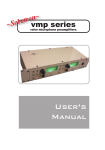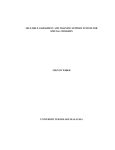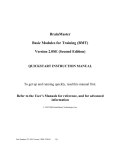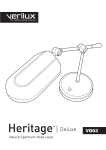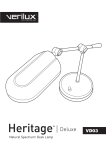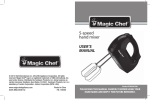Download Untitled
Transcript
Thankyou for purchasing a Sebatron unit. We are sure it will give you many years of solid use and take your music to another sonic dimension. We produce original, innovative audio equipment that is serious value for money. To get the best performance, we recommend you switch on the unit and let the valves warm up while you read this manual. Table of Contents Page 1. INTRODUCTION Introduction 2. 1 FEATURES Front Panel Preamplifier Compressor Meter Rear Panel Ventilation - Like all other Class A equipment, this unit will produce heat during normal operation . Please consider this when mounting, do not block the ventilation holes, do not place directly above or below hot equipment (e.g. amplifiers, power supplies, heaters - preamplifiers are also best kept away from this kind of equipment due to electrical noise) Power Source - Your unit is factory preset to your local voltage on shipping and this voltage is marked on the rear of the unit. Please check this carefully before powering up the unit! We are not responsible for any damage caused by incorrect voltage settings. Servicing - Please do not open the case unless instructed to do so by Sebatron. There are no user serviceable parts inside, apart from the valves. If your unit is not performing as expected please contact your dealer to find the nearest authorised service agent. 3. USING THORAX Setup and Use Recommended Settings 2 4 6 8 10 14 THORAX Introduction Thorax is a complete recording channel in one box. It consists of a valve microphone preamplifier based on the Sebatron VMP Series, switchable high and low EQ and an optically controlled valve compressor. It is of course free of integrated circuits, being fully discrete Class A with valves run from proper high tension rails. But Thorax is more than just another channel strip with nice specs. It has some unique Sebatron circuitry and features that will enable you to create new tonal possibilities. The preamplifier section is an expansion of the VMP Series circuit with more possibilities in the switchable passive EQ and more valve warmth available via the Colour control. It can be driven ultra clean for transparency or pushed through warm valve tones and into distortion. The EQ can boost or cut the extreme high and low frequencies to enhance or clean up your signal and is fully bypassable. Thorax’s compressor stage uses a unique Sebatron-designed optically driven gain reduction circuit that gives fast, tight control over the dynamics of a signal with a minimum of colouration. It has controls for Threshold, Ratio, Attack and Release, with the attack/release factor switchable over three ranges. Makeup gain is provided by a valve stage with a three position Drive control. This audio path is complemented by a large, easy to read VU meter that can be switched to indicate preamp or main output level or compressor gain reduction. 1 THORAX Pre-amplifier Transformer Balanced XLR Microphone Input The Phantom Off/On switch can be used to provide phantom power to the XLR inputs when required. Input Pad Pre-amp Output Level Phase Reverse DI Input Air - High Shelf EQ EQ Bypass Colour 48V Phantom Power 2 The preamplifier stage of Thorax has several input options. A balanced microphone can be connected to either the front or rear XLR input or an unbalanced instrument or line level signal can be connected via the DI Input. Deep - Low Shelf EQ The Input Pad will attenuate the signal before it reaches the valve, which enables hot line level signals to be amplified cleanly. The Pad is also interactive with the Air high shelf EQ. More Pad creates a stronger EQ curve, with the ranges overlapping for a huge spectrum of EQ possibilities. Phase Reverse can be used to allow for phase differences between microphones when using multi mic techniques. If the combination of microphones (e.g. top and bottom of snare) is sounding thin or weak, try reversing the phase. Colour controls the gain from the valve, and as a result, the amount of valve warmth. Low settings will give a clean and transparent sound, while driving the valve harder will result in warm or even distorted sounds. The Air High Shelf EQ and Deep Low Shelf EQ consist of a range of musically useful cut and boost curves. They can be switched to a flat frequency response with the EQ Bypass. The preamp Output Level controls the signal level being sent to the preamplifier outputs. On the rear of the unit there is a balanced XLR output which operates at a nominal +4dBU for recording, a lower level TRS balanced/ unbalanced output intended for direct monitoring and the internal send to the Compressor, accessible through the compressor input/insert. 3 THORAX Compressor The Thorax Compressor is optical based, but thanks to some unique Sebatron circuitry is faster and has a wider dynamic range than traditional optical compressors. The Compressor Input Insert is a TRS jack on the rear of the unit. The signal path between Preamplifier and Compressor can be interrupted here to use each section independently, or to insert another processor such as a parametric equaliser between them. Threshold, Ratio, Attack and Release are all standard compressor controls. If you are unsure what they do, we recommend you read some of the many excellent explanations of compression available on the internet before using it while tracking. Ratio Threshold Attack Release Compression Drive is related to Colour in the preamp. It controls the amount of valve gain in the compressor stage and can be used to provide gain make-up or simply for more warmth. The Compressor Bypass switch nulls the compression control voltage, which stops any attenuation of the signal passing through the valve. This can be used to compare the compressed signal to the dry or to use the compressor stage as a pure valve line amplifier. The range of the Attack and Release controls can be Fast, Medium or Slow by using the Attack/Release Factor switch. There is some overlap between the ranges, enabling very fine detail setting of the attack and release times. comp drive comp bypass attack / release factor output level The Output Level controls the signal level being sent from the compressor to the two main outputs on the rear of the unit. There is a balanced XLR output which operates at a nominal +4dBU for recording and a lower level TRS balanced/unbalanced output intended for direct monitoring. Also at the rear of the unit is a Sidechain Insert. This TRS jack interrupts the audio signal on it’s way to the level detection circuitry. You can insert your own audio signal here to control the compression from another source. 4 5 THORAX Meter The metering section allows you to gain an insight into the internal operations of Thorax. The amount of gain reduction occurring in the compressor can be indicated by switching the Meter Source to GR. The meter should then sit at 0dB and the meter markings will indicate the amount (in dB) of gain reduction. Meter Source With the Meter Source set to O/P the O/P meter options become active. These controls give you the choice of preamp or main output levels over 3 possible ranges. Power Switch Output Meter Options 6 The medium range is calibrated to 0dBu at the XLR balanced outputs. The other settings enable you to monitor both the upper ranges of modern high headroom equipment and the lower signal levels possible with 24 bit recording. Always remember that the VU specification was developed with tape in mind, and as a result only represents a fraction of the dynamic range possible with todays digital recordings. All Sebatron products are designed with this wide dynamic range in mind and the limitations of the meter in no way represent the limitations of the unit. Because we use no integrated circuits, there is no hard clip point, only a gradual increase in valve warmth and then distortion that can be musically useful. What this means is that if the meter is slamming against the stops but the sound is just what you want, switch the meter to a lower level or to GR and follow your ears. The input meters of your recording device show the only truly important levels. 7 THORAX Rear Panel Voltage Selector Switch Tip = Compressor Line In/Receive Ring = Preamp-Out/Send Compressor Insert/Input 120v 240v 1.25A Slow Mains Input The Main and Preamp XLR and TRS outputs are fully balanced by discrete Class A driver circuits. They follow the industry standard Pin 2 Hot pinout. Main XLR and TRS Outputs Fuse 8 Transformer Balanced XLR Microphone Preamp Input Sidechain Input Tip = Comp Key Receive Ring = Comp Key Send The rear panel of Thorax contains most of the input and outputs and the IEC mains connector. The input voltage range is switchable between 110-120V and 220-240V. Make sure it is set correctly before you switch the unit on! Sebatron units are built tough and usually survive abuse, but we don’t guarantee it. The sidechain input interrupts the audio signal being sent to the level detection circuitry which controls the compressor. This is normally the audio that is being compressed, but through the use of the sidechain you can either process the signal and then send it back or introduce an entirely different signal. See Usage for more details. The Compressor Insert/Input is a TRS jack that normally sends the preamp output to the compressor input. You can use an insert splitter cable to further process the signal between the preamp and compressor, e.g. with further EQ. Preamp XLR and TRS Outputs This insert also allows you to use the pre and compressor sections individually. Use a standard unbalanced patch cable or guitar lead to inject a signal into the compressor. There is quite a bit of gain available through use of the Compression Drive switch, making it possible to run a vocal microphone through the pre and a guitar or bass through the comp. 9 THORAX Using Thorax is a complex device with many possibilities, but don’t be intimidated. It is like a quality musical instrument, you can use it in a basic manner while you’re learning and it will do the job well, but with time you will start to really understand the subtleties and how to bring them out. There are many organic anomalies that allow the circuitry to naturally stabilize any signal without sounding flat and lifeless. On the contrary, the unit will react musically. Tracking should be a breeze with an array of tracks ‘stacking up’ perfectly. Subtle compression on the way in means presence and width. The default setting revolves around ‘ cool ‘ compression drive, 0db to 6 db colour with no pad. For higher gain applications it is advisable to switch to the ‘warm ‘ or ‘hot ‘compression drive settings where gain makeup in the second half is much higher. For higher level D.I inputs or loud condenser mics it may be desirable to use the pad settings... Follow this guide for initial SETUP of thorax Control Power Output Level Meter options Threshold Compression Drive Colour Phase Pad Deep + Air EQ Preamp Level 10 Initial Setting > 10mins 0 pre-amp fully right cool 0 in 0dB 0 out 5 Notes warm up time for valves increase after signal is present set to indicate preamp output level no compression low compressor gain makeup for a clean signal Flat EQ Bypass EQ Connect the Main output to your recording device. A balanced cable will give the best signal to noise ratio but make sure that you are connecting to a line level input, not a microphone input. Many modern computer recording interfaces have 2 or more XLR microphone inputs and several TRS line inputs. In this case, use a balanced XLR to TRS cable or if unavailable a balanced TRS to TRS cable from Thorax’s TRS output. DON’T connect a balanced line level output directly to an XLR Mic input, the signal levels will not be matched, resulting in increased noise and possible distortion, and there is a chance of damage ocurring to the line level unit if phantom power is switched on. If you require a separate monitoring signal, you should connect a balanced or unbalanced cable from the TRS output to your mixer. Connect a microphone to either the front or rear XLR inputs. Apply phantom power if required. Alternatively, a line level signal or instrument can be used via the DI input. The meter should indicate a signal now. If it is too low, increase the preamp level and possibly the colour control. If it is too high, engage the Pad switch. You can now increase the main Output Level and you should hear your signal. Preamplifier The preamplifier stage is based on the Sebatron VMP Series and shares many of the same characteristics. The Colour control is an extension of the Pad switch on the VMP and can be used to change the amount of gain available from the valve, which means more second order harmonics and soft clipping compression when driven hard. Keeping the Colour low will give you a clean, transparent signal, while increasing it will make your sound warmer and eventually distorted, with each of the settings having a slightly different curve. A whole myriad of possibilities that can’t be obtained from chip based units exist within the circuitry. Similar overall gain settings ( e.g. 0db pad, 6 db colour OR 10db pad, 12 db colour) will have totally different sonic textures. 11 Compressor The Thorax EQ consists of high and low shelves, and can also be thought of inversely as a broad mid-range bandpass filter. For example, a high and low boost is the same as a mid cut. Use the Eq in/out switch to do A/B comparisons with the flat signal. Compression is occurring when the Active LED is lit, and the amount of gain reduction can be indicated by switching the meter source switch to GR. Best compression settings usually occur when the active led is flickering and the louder peaks are registered by the ‘gain reduction‘ meter. The Air shelf enables you to boost the high frequencies before any gain stages or other noise sources, which means the cleanest possible signal. There are two cut and three boost settings, which move the high shelf to progressively higher frequencies. The compressor action can be completely bypassed by switching the ‘ compressor ‘ switch to ‘out’. This switches off the level detection circuitry while still running the signal through the valve gain stage, and can be used for A/B comparison or for obtaining more pure valve gain, similar to daisy chaining two channels of a VMP Series preamp. The Deep switch changes the low frequency response of Thorax, with two cut and three boost settings of increasing intensity. Ultra low frequencies can be difficult to control, with slow rise and fall times and a lot of power contained within the signal. Careful attention has been paid to these frequencies, with plenty of headroom allowed, which means fatter bass for you! Use the Pad switch to attenuate high signal levels for a cleaner sound. This control also affects the Air EQ curve, increasing the Pad increases the depth of the Air setting. The Air factor is most prominent with a -20dB Pad setting. Allow your self time to know the E.Q settings and how they are ‘factored ‘ with the pad control. The Preamp Level controls the signal level from the preamplifier direct outputs, which are on the rear of the unit adjacent to the microphone input. This also controls the amount of signal being sent from the preamplifier to the compressor, so you can drive the preamp heavily using the colour and pad controls and then reduce the output level to prevent overloading the compressor. 12 Default mode for the Compression is ‘ cool ‘ and ‘ fast ‘, with most flexibility attainable in these modes. To properly exploit the full compression dynamics of the THORAX it is highly advised not to run the threshold parameter fully counter clockwise as an overload of compression activity may result in subtle audible distortion. An EQ can be used as an insert across the compressor sidechain for limiting the frequency response of the compressor so that only certain frequencies are detected, for example in de-essing. To do this, use an insert cable that splits a ‘stereo’ jack into two mono jacks. The ‘ring’ connection will send the audio signal to your EQ, the ‘tip’ connection will send the processed signal back to Thorax. A different signal can be used to ‘duck’ the audio, for example reducing a background track during a voice over. To do this, simply use a normal unbalanced patch lead to inject the ‘master’ audio signal into the sidechain. For stereo linking of two Thoraxes, connect the Sidechain Send of one channel to the Return of the second channel. This can be done with an unbalanced patch lead inserted halfway into the ‘master’ Thorax’s sidechain to obtain the ‘send’ without interrupting the signal flow. The other end is fully inserted into the ‘slave’ Thorax sidechain. The compressor controls are still independent, so make sure they are closely matched for stereo operation. 13 Fat Bass Recommended Settings To get you started we have included some basic settings. All of the settings, especially compression, are very dependent on the signal source, including the transient and harmonic content. Basically, you should always listen carefully, don’t assume the obvious and be open to the unexpected. This applies to any audio control device. We have also included some blank sheets for you to photocopy and record your own settings. Preamplifier Driven Control Pad Preamp Level Colour Setting 0dB low high For a rich and warm sound Notes Let lots of signal in to drive the valve Control the output level so you don’t overdrive the next section Lots of gain and valve colour Ultra Clean Control Pad Preamp Level Colour 14 Setting -10dB -20dB high low For a transparent sound Notes Use 0dB or -15dB if more gain is needed Open up the output Less valve drive = purer, flatter tones Control Pad Colour Deep Setting 0dB high Deep2 Notes Let lots of signal in to drive the valve Lots of gain and valve colour Back off here if it’s too much Acoustic Guitar Control Pad Colour Deep Setting -10dB Low Gaunt Notes Leave headroom for transients Keep it clean Cut off some boominess Kick Drum Control Pad Colour Setting -10dB LowMedium Deep Notes Leave headroom for transients As required Add to taste Snare Drum Control Pad Colour Deep Air Setting -10dB LowMedium Notes Leave headroom for transients As required Add to taste Add to taste 15 Compressor Vocal Tracking Control Ratio A/R Factor Setting ~10:1 Medium Notes Set threshold for gentle control of peaks Tune Attack and Release controls for best results Tight Bass Control Ratio A/R Factor Setting High Fast Notes Set threshold to taste Set attack to fast, release as required Acoustic Guitar Control Ratio A/R Factor Setting ~10:1 Fast Notes Control peaks, leave the rest alone Set attack to fast, release as required Kick Drum Control Ratio A/R Factor Setting ~Infinity:1 Fast Notes Set very high Set A and R as fast as possible Snare Drum Control Ratio A/R Factor 16 Setting ~Infinity:1 Fast Notes Set very high Set Attack as fast as possible, release as required ~Sebatron~ Date Source Notes Control Input Used Pad Phase EQ Bypass Preamp Level Colour Deep Air Threshold Ratio Attack Release A/R Factor Compression Drive Output Level GR amount Pre Signal Level Output Signal Level Sidechain Thorax User Settings Setting Notes ~Sebatron~ Date Source Notes Control Input Used Pad Phase EQ Bypass Preamp Level Colour Deep Air Thorax Setting User Settings Notes ~Sebatron~ Date Source Notes Control Input Used Pad Phase EQ Bypass Preamp Level Colour Deep Air Threshold Ratio Attack Release A/R Factor Compression Drive Output Level Threshold Ratio Attack Release A/R Factor Compression Drive Output Level GR amount Pre Signal Level Output Signal Level Sidechain GR amount Pre Signal Level Output Signal Level Sidechain Thorax User Settings Setting Notes thorax preamp stage +300 V high tension supply t r a in ns pu fo t rm er direct injection 12AT7 valve pad +60V supply preamp outputs air colour compressor input preamp output level deep output buffers +300 V high tension supply 12AT7 valve main output level compression drive sidechain input dynamics detection +60V supply opto attenuator circuit thorax compressor stage output buffers compressor outputs













